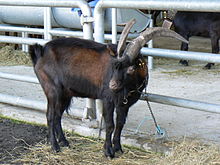The Alpina Comune is a heterogeneous population of domestic goats widely distributed in the Alps of northern Italy, particularly in the regions of Lombardy and Piemonte. It is highly variable in size, in morphological characteristics such as the type, colour and pattern of its coat and the shape and carriage of its ears, and in type of use. It does not display any of the uniformity characteristic of a breed, other than a consistent hardiness and adaptation to mountain terrain. It is however officially recognised and protected as one. The name Alpina Comune, "common", is more used in Piemonte; in Lombardy it may be called Alpina Locale, "local", or simply Nostrana, "ours".[4]
 | |
| Conservation status | FAO (2007): not listed[1] |
|---|---|
| Other names |
|
| Country of origin | Italy |
| Distribution | |
| Standard | MIPAAF |
| Use | varied[2] |
| Traits | |
| Weight | |
| Height | |
| Wool colour | very variable, polychrome |
| Horn status | horned or hornless |
| Beard | usually bearded |
| |
Distribution and numbers
editThe Alpina Comune is raised throughout Piemonte, from the mountains of the province of Cuneo to those of the province of Verbano-Cusio-Ossola, and in a large area of the Lombard Alps including the Brianza, the Canton of Ticino, the Grisons, the Lario, the Alpi Orobie, the Val Camonica, the Valchiavenna and the Valtellina.[2] Management is extensive: the animals are kept on medium or high alpine pasture in the summer months.[2]
The Alpina Comune is classed as one of the forty-three autochthonous Italian goat breeds of limited distribution; a herdbook is kept by the Associazione Nazionale della Pastorizia, the Italian national association of sheep- and goat-breeders.[5][6]: 89 At the end of 2013 the registered population was variously reported as 497, almost all of which were in Val d'Aosta,[7] and as 510.[8] Figures for the total size of the population vary widely. It was estimated at 22,000 in 1973, and in 2001 at 55,000.[2] Another estimate in 2002 reached the same figure, with 40,000 in Piemonte and 15,000 in Lombardy,[9] while a population of 100,000 was estimated both in 2005[4] and in 2008.[2]
Use
editThe Alpina Comune is raised both for meat and for milk. The milk yield is approximately 400–600 kg per lactation of 180–270 days. The milk is used to make cheeses, either pure caprino or mixed-milk, including Toma, Raschera, Bra and robiola. Kids are usually slaughtered at a weight of 10–13 kg; the meat of adult animals is used to make salumi such the violino, a goat's-meat prosciutto. The products vary from place to place depending on the local traditions of the area.[2]
References
edit- ^ Barbara Rischkowsky, D. Pilling (eds.) (2007). List of breeds documented in the Global Databank for Animal Genetic Resources, annex to The State of the World's Animal Genetic Resources for Food and Agriculture. Rome: Food and Agriculture Organization of the United Nations. ISBN 9789251057629. Accessed July 2014.
- ^ a b c d e f Daniele Bigi, Alessio Zanon (2008). Atlante delle razze autoctone: Bovini, equini, ovicaprini, suini allevati in Italia (in Italian). Milan: Edagricole. ISBN 9788850652594, pages 314–15.
- ^ a b c d Norme tecniche della popolazione caprina "Alpina": standard della razza (in Italian). Associazione Nazionale della Pastorizia. Accessed July 2014.
- ^ a b Lorenzo Noè, Alessandro Gaviraghi, Andrea D'Angelo, Adriana Bonanno, Adriana Di Trana, Lucia Sepe, Salvatore Claps, Giovanni Annicchiarico, Nicola Bacciu (2005). Le razze caprine d'Italia (in Italian); in: Giuseppe Pulina (2005). L' alimentazione della capra da latte. Bologna: Avenue Media. ISBN 9788886817493, pages 381–435. Archived 5 October 2014.
- ^ Strutture Zootecniche (Dec. 2009/712/CE - Allegato 2 - Capitolo 2) (in Italian). Ministero delle Politiche Agricole Alimentari e Forestali. Section I (e). Archived 4 May 2014.
- ^ Le razze ovine e caprine in Italia (in Italian). Associazione Nazionale della Pastorizia: Ufficio centrale libri genealogici e registri anagrafici razze ovine e caprine. Accessed July 2014.
- ^ Consistenze Provinciali della Razza L1 Alpina Anno 2013 (in Italian). Associazione Nazionale della Pastorizia: Banca dati. Accessed July 2014.
- ^ Breed data sheet: Alpina/Italy. Domestic Animal Diversity Information System of the Food and Agriculture Organization of the United Nations. Accessed July 2014.
- ^ Michele Corti, Luigi Andrea Brambilla (2002). Le razze autoctone caprine dell’arco alpino e i loro sistemi di allevamento (in Italian). Conference papers: L’allevamento ovicaprino nelle Alpi: Razze, tradizioni e prodotti in sintonia con l’ambiente; Cavalese, 21 September 2002, pages 61–80. Accessed July 2014.